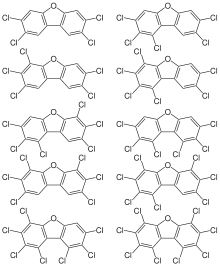Polychlorinated dibenzofurans
- Polychlorinated dibenzofurans
-

General chemical structure of PCDFs, where 2 ≤ n+m ≤ 8

Structures of the ten 2,3,7,8-substituted PCDF
congeners that are toxicologically of most relevance
Polychlorinated dibenzofurans (PCDFs) are a group of halogenated organic compounds which are toxic environmental pollutants. They are known teratogens, mutagens, and suspected human carcinogens. PCDFs tend to co-occur with polychlorinated dibenzodioxins (PCDDs). PCDFs can be formed by pyrolysis or incineration at temperatures below 1200 °C of chlorine containing products, such as PVC, PCBs, and other organochlorides, or of non-chlorine containing products in the presence of chlorine donors.[1]
References
- ^ "Proceedings of the Subregional Awareness Raising Workshop on Persistent Organic Pollutants (POPs), Bangkok, Thailand". United Nations Environment Programme. November 25-28th, 1997. http://www.chem.unep.ch/pops/POPs_Inc/proceedings/bangkok/FIEDLER1.html. Retrieved 2007-12-11.
Further resources
See also
Categories:
- Organochlorides
- Incineration
- Persistent organic pollutants
- Immunotoxins
- Dibenzofurans
Wikimedia Foundation.
2010.
Look at other dictionaries:
Polychlorinated biphenyl — PCBs redirects here. For printed circuit boards, see printed circuit board. Labelling transformers containing PCBs … Wikipedia
Polychlorinated dibenzodioxins — See also: 2,3,7,8 Tetrachlorodibenzodioxin, Dioxins and dioxin like compounds, and 1,4 Dioxin General structure of PCDDs where n and m can range from 0 to 4 Polychlorinated dibenzodioxins (PCDDs), or simply dioxins, are a group of organic… … Wikipedia
Dioxins and dioxin-like compounds — (DLC)[1] are by products of various industrial processes, and are commonly regarded as highly toxic compounds that are environmental pollutants and persistent organic pollutants (POPs).[2] They include:[1][3] Polychlorinated dibenzo p dioxins… … Wikipedia
Dibenzofuran — Identifiers … Wikipedia
Chloracne — Classification and external resources ICD 10 L70.8 DiseasesDB 31706 … Wikipedia
1,4-Dioxin — For the general class of dioxin compounds which are environmental pollutants, see polychlorinated dibenzodioxins. Not to be confused with dioxane or digoxin. 1,4 Dioxin … Wikipedia
Stockholm Convention on Persistent Organic Pollutants — The logo of the Stockholm Convention Secretariat Type United Nations treaty Signed 23 May 2001 Location Stockholm, Sweden Effective 17 May 2004 Condition Ninety days a … Wikipedia
Teratology — A two headed calf Teratology is the study of abnormalities of physiological development. It is often thought of as the study of human birth defects, but it is much broader than that, taking in other non birth developmental stages, including… … Wikipedia
Pentachlorophenol — IUPAC name 2,3,4,5,6 Pentachlorophenol … Wikipedia
Persistent organic pollutant — State parties to the Stockholm Convention on Persistent Organic Pollutants Persistent organic pollutants (POPs) are organic compounds that are resistant to environmental degradation through chemical, biological, and photolytic processes … Wikipedia
 Structures of the ten 2,3,7,8-substituted PCDF congeners that are toxicologically of most relevance
Structures of the ten 2,3,7,8-substituted PCDF congeners that are toxicologically of most relevance

